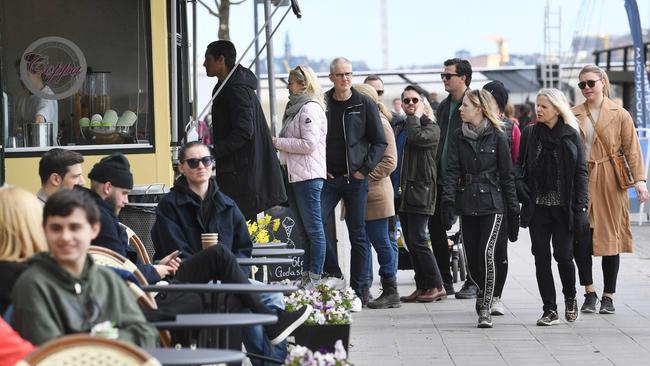Coronavirus: ‘Elimmunity’ could be corona magic bullet
Australia may need to compromise our ‘elimination’ push by vaccinating the elderly and letting the virus circulate among the young.

All eyes are on Sweden. Has this Nordic outlier now got to the point of near-herd immunity in dealing with COVID-19, meaning the Swedes can continue with their daily lives in a normal fashion? Some virologists and scientists believe so.
Countries around the world all desire herd, or population, immunity to protect their citizens from COVID-19, but how they plan to achieve it varies.
Australia appears to be pinning its hope on a viable vaccine, while Sweden has gone for a more natural model — eschewing face masks and lockdowns and allowing COVID-19 to infect its population while attempting to protect its vulnerable.
In the process, critics of this approach, including leading US infectious disease expert Anthony Fauci, point out that nearly 6000 Swedes — mainly elderly and in nursing homes — have died.
Statistics Sweden says the overall number of deaths this year is on par with previous years. And figures from neighbours Denmark and Norway, which both opted for harsher lockdown measures, have found the same.
The notion of herd immunity means that enough people in a population become immune to the virus to the point that the virus can’t find enough people to infect, and therefore dies out. Any outbreaks thus become small and manageable.
No one believes the virus can be completely eliminated. And while the Australian and New Zealand lockdown strategies are buying time for a vaccine solution, every country will at some point have to work out how to manage living with the virus.
Whether that is by having most of Australia vaccinated, as Scott Morrison has alluded to — if a viable vaccine ends up working for the elderly and the vulnerable — or by slowly trying to allow the virus to circulate among the young and fit, is yet to be decided.
The political direction — perhaps a mash of the two — will depend on vaccine developments in the coming months.
Some scientists and doctors believe 50 to 60 per cent of the population needs to be immune by vaccination or by infection before a form of herd immunity is achieved. Some areas that have been hit hard in the initial stages of the pandemic show sero-prevalence levels among high-density city dwellers and commuter-packed travellers of about 17 to 25 per cent.
In one New York centre of poor Latino workers, 68 per cent were found to have been infected. In other less-populated areas, such as across Spain, the numbers are much lower.
However, recent scientific analysis has discovered that many sero-prevalence studies are failing to detect people who have had mild COVID-19 symptoms.
For some months now, researchers have believed the body’s B cells and T cells provide people with a “functional’’ immunity to COVID-19 once they have been exposed to the coronavirus, whether they suffered severely or asymptomatically. This means the body’s immune systems are primed to fight the virus again because they recognise it through infection or vaccination.
So while COVID-19 antibodies wane over a few months after infection, the T cells, which can directly kill virus-infected cells, and B cells, which produce pathogen-specific antibodies, kick into action when the body is re-exposed, and any new infection may be very mild.
Some scientists believe large swaths of the population already have this cellular form of immunity through exposure not only to mild COVID-19 but to other coronaviruses, and so the required effective herd immunity level — the percentage of people who show up with antibodies — may turn out to be much lower than 50 per cent.
Kim Sneppen, from the Niels Bohr Institute in Copenhagen, believes Sweden might have beaten the pandemic. He told Denmark’s Politiken newspaper: “There is some evidence that the Swedes have built up a degree of immunity to the virus which, along with what else they are doing to stop the spread, is enough to control the disease.’’
Swedish casualty doctor Sebastian Rushworth said he hadn’t seen a COVID-19 patient in two months, and there was no longer a separate section for coronavirus patients in his hospital.
The country’s top public health official, epidemiologist, Anders Tegnell, said deaths from coronavirus were not related to the number of cases in a country, but rather whether elderly people were being infected and how well the health system was coping.
Cases of COVID-19 have skyrocketed in recent weeks across Europe, yet the hospitalisation and death rates have remained very low, prompting some to believe that the most vulnerable have previously been hard hit and increased testing is picking up cases in much younger people.
Edinburgh University emeritus professor of public health Raj Bhopal said the question of herd immunity had presented politicians with “zugzwang” — a position in chess where every move is disadvantageous but every strategy has to be examined, no matter how unpalatable.
“If safe and effective vaccines and lifesaving preventive and therapeutic medications are not found, lengthy lockdowns prove impossible and the pandemic does not disappear spontaneously, population (herd) immunity is the only long-term solution,’’ Professor Bhopal said.
He believes if the young and healthy acquired COVID-19 naturally, it would arguably be the safest way towards a goal of about 50 per cent population immunity.



